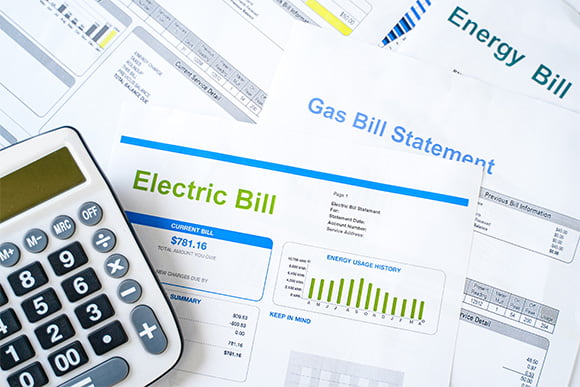Energy Audit – In this economy, every CFO, Treasury Department, and Accounting Office are all taking note of the stunning increase in the cost of electricity. Where once a line item of operational expenses and not given much attention, it now stands out as a significant expense and profit beater for most companies.
Modern Thermal Design recommends that any company begin its expense evaluation by first knowing what is causing the spike in costs. A utility bill audit will analyze the utility bills of a company to initially look for classification errors by the utility. The audit can be done by our team of professionals who already know what they are looking for and can provide counsel on whether your facility is a good candidate to become an Independent Power Station.


What May Be Uncovered During a Utility Audit?
During a utility audit, you will be looking for any of the following:
- Incorrect late fees.
- Being billed at the wrong rate plan.
- Opening or closing accounts on time.
- Errors in the invoice, such as numbers that have been transposed; for example, instead of $46.00, it was put down as $64.00.
Common Errors on Utility Bills Include:
- Reading the meter wrong
- Rate overcharges
- Incorrect rate plan for example you may be listed at total electric but use natural gas for heat and hot water.
- Typographical mistakes, such as transposed numbers
- Mainframe errors
- Defective equipment
How is a Utility Audit Performed?
Here are the basic steps for a utility audit.
- Gather data.
- Review all the data.
- Database compilation.
- Documents are acquired from utility companies.
- Detailed analysis.
- Gathering of any supplemental information or documentation.
- Refund claims.
- Fieldwork.
- Additional claim.
- Final report.
When a utility audit is performed you will know exactly where there has been any errors. You will then get a refund or credit on your next utility bill.

Three Reasons Utility Audits Work
There are three reasons to have a utility audit done on your company. They include:
- Low risk because they are performance-based and customized to your business
- It is specialized work that would go undetected for years. With all the regulations and rules, it takes an expert to go through them.
- 70% plus of all companies find savings and sometimes BIG savings.
Knowing Your Utility Rate Plans
To know which utility rate plan is best for you, these are the things you need to look at.
- Utilized your utility rate database, so you know what rate options are available.
- Does your utility offer time-based pricing, such as using more at night for a lower price?
TERM | DEFINITION |
|---|---|
Bundled rate |
Both the electric supply (kWh consumed) and the electric delivery (transmission and distribution) are provided by the same provider. |
Unbundled rate |
The electric supply (kWh consumed) and the electric delivery (transmission and distribution) are provided by different providers. These can be billed separately (site receives two separate bills) or together (site receives one bill that includes both charges). |
Time-of-use demand charges |
Demand charge based on the site's maximum demand only during specified hours. Can have multiple time-of-use periods (for example, a rate may have both an on-peak demand charge during the middle of the day, and a separate shoulder or part-peak demand charge. Can vary by season (for example, summer on-peak demand charges may be higher than winter on-peak demand charges, or winter on-peak demand charges may be non-existent). |
Non-coincident demand charges |
Demand charge based on the highest monthly demand, regardless of time of day. Can be instead of or in addition to on-peak demand charges. |
Demand charge look-back (ratchet) |
Methodology of calculating demand charge by considering both the current month and previous months' peaks. Often calculated as the maximum of current month's peak demand, and X% of previous 11 months' peak demand. Applies to both time-of-use and non-coincident demand charges. This means that occasional high spikes in electricity consumption can set the demand charge for the rest of the year. |
System-peak demand charge |
Based on site's contribution during utility system peak. Examples include PJM's 5CP charge (applied to average load usage during PJM's 5 highest non-coincident peaks) and ERCOT's 4CP charge (applied to average load during system coincidental peaks occurring in June, July, August, and September). |
Standby and departing load charges |
Charges based on site electric load, not utility purchases, that cannot be offset by distributed energy projects. |
Minimum import requirement |
The minimum amount of electricity that a site must purchase from the utility provider at all times. Can be based on size of distributed generation assets. |
Understanding Fees and Pricing
You need to understand the fees and pricing that most utility auditing companies have.
There are three ways that they get paid.
- Fixed fee – is precisely what it sounds like they will give you an estimate or a fee not to be exceeded for the time they work on it.
- Hourly – again exactly like it sounds but find out how much they charge by the hour; some can be up to $250.00 an hour.
- Contingency – This sounds good, and for most people, it is, but understand the percentage (Contingency fees range from 50% of the savings to as low as 35%), but that is only if they find errors on your utility bills.
Utility Bill Auditing by Modern Thermal Design
We have experts and specialists to do audits. If we do not find any errors, you owe us nothing. We make sure you are in a suitable class for your utility. You can call us at 317-934-5702 to find out how we do utility audits and if we can help you.

